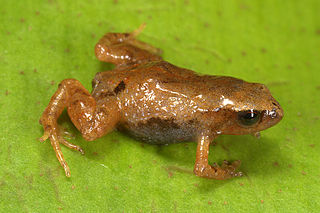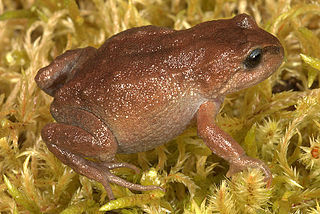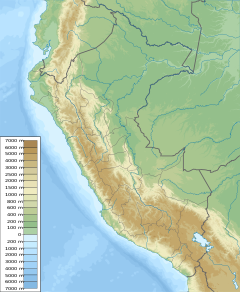
Phrynopus is a genus of frogs of the family Strabomantidae. Their common name is Andes frogs. They are endemic to Peru and inhabit the upper humid montane forest and supra-treeline grassland in the Cordillera Oriental, with one record from the Peruvian Cordillera Occidental.
Yunganastes ashkapara is a species of frog in the family Strabomantidae. It is endemic to Bolivia and is known from the vicinity of its type locality in the Chapare Province and from Abra de la Cruz in the Manuel María Caballero Province. The specific name ashkapara is derived from Quechuan ashka meaning "a lot" and para for "rain", and refers to the very high rainfall in the region of the type locality.
Oreobates saxatilis, also known as Tarapoto big-headed frog, is a species of frog in the family Strabomantidae. It is endemic to Peru and known from near its type locality near Tarapoto as well as from the Río Tambo District in the Satipo Province, Panguana in the Puerto Inca Province, and Río Kimbiri in the La Convención Province.
Phrynopus bracki is a species of frog in the family Strabomantidae. It is endemic to Peru and only known from its type locality in the Cordillera Yanachaga, Pasco Region. The specific name bracki honors Antonio Brack, agronomist and ecologist who was instrumental for the establishment of the Yanachaga–Chemillén National Park. Common name Brack's Andes frog, has been coined for it.
Phrynopus dagmarae is a species of frog in the family Strabomantidae. It is endemic to the Andes of Peru and only known from the Pachitea and Ambo Provinces in the Huánuco Region, from near the type locality. The specific name dagmarae honors Dagmar Schramm from Germany.

Lynchius flavomaculatus, also known as the yellow-spotted Andes frog, is a species of frog in the family Strabomantidae. It is found in the Andes of southern Ecuador and northern Peru.

Phrynopus kauneorum is a species of frogs in the family Strabomantidae. It is endemic to the Andes of Peru and known from near its type locality in the Pachitea Province, as well as from the Cordillera de Carpish, both in the Huánuco Region. The specific name kauneorum honors Andreas, Meeta, and Rebekka Kaune from Germany.
Niceforonia lucida is a species of frog in the family Strabomantidae. It is endemic to Peru and known from the Cordillera Central west of the Apurímac River in the Ayacucho Region. Common name Cannatella's Andes frog has been coined for it. The specific name lucida refers to distinctive coloration of this frog relative to frogs in the genus Phrynopus, the genus where this species was initially placed. However, later studies have moved it to other genera where its colors are less distinctive.
Phrynopus montium is a species of frog in the family Strabomantidae. It is endemic to Peru and only known from two localities near Cascas in the Junín Region: "Cascas near Huasahuasi", the imprecisely known type locality where the types were collected in 1936, and south of Hacienda Cascas, where it was found in 2014. Records from the PascoPasco and Huánuco Regions refer to Phrynopus kotosh and Phrynopus oblivius, respectively. Common name Cascas Andes frog has been coined for this species.
Lynchius parkeri, also known as Parker's Andes frog, is a species of frog in the family Strabomantidae. It is found in northern Peru and southern Ecuador. The specific name parkeri honors Hampton Wildman Parker, English zoologist and herpetologist.
Oreobates pereger, also known as the Ayacucho Andes frog, is a species of frog in the family Strabomantidae. It is endemic to Peru where it is known from the eastern slopes of the Cordillera Oriental and Cordillera Vilcabamba mountain ranges.

Noblella peruviana is a species of frog in the family Strabomantidae. It is endemic to the Andean highlands in Peru.

The Strabomantidae, sometimes called cloud forest landfrogs, are a family of frogs native to South America. These frogs lack a free-living larval stage and hatch directly into miniature "froglets". This family includes Pristimantis, the most speciose genus of any vertebrate. Based on molecular dating, the Holoadeninae in particular appears to have originated in the Eocene. The Oligocene-Miocene transition was also found to be important to their biogeographical history. However, the lack of Holoadeninae fossils and limited nucleotide data ambiguates the results, by the authors' admission.

Bryophryne is a genus of frogs in the family Strabomantidae. These frogs are endemic to south-eastern Peru in the Cusco Region, with an undescribed species from the Puno Region. Their range is separated from that of Phrynopus by the Apurímac River valley.
Phrynopus tribulosus is a species of frog in the family Strabomantidae. It is endemic to Peru and only known from its type locality near Oxapampa at 2,600 m (8,500 ft) asl, and from Santa Bárbara, in the Huancabamba District, Oxapampa, Pasco Region. It inhabits humid montane forests where individuals could be found deep within a mossy bank by day.
Oreobates ayacucho is a species of frogs in the family Strabomantidae. It is endemic to Peru and known from a few localities in the Ayacucho Region in the Peruvian Andes. The species is only known from 11 specimens.
Phrynopus kotosh is a species of frog in the family Strabomantidae. It is endemic to Peru and only known from its type locality near Huancapallac, Huánuco Region, at 2,950 m (9,680 ft) asl in the Cordillera Central. The specific name refers to the pre-Columbian culture Kotosh; ruins from this culture are known from the area of the type locality.
Phrynopus oblivius is a species of frog in the family Strabomantidae. It is endemic to central Peru and only known from near its type locality near Maraynioc, in the Tarma Province, Junín Region, at about 3,210–3,220 m (10,530–10,560 ft) asl. It is known from a collection in 2005; there has been no later surveys for the species.

Lynchius is a genus of frogs in the family Strabomantidae. The name honours herpetologist John D. Lynch. The distribution of Lynchius is restricted to the Cordillera Oriental in southern Ecuador and Cordillera de Huancabamba in northern Peru.

Psychrophrynella usurpator is a species of frogs in the family Strabomantidae. It is endemic to Peru and known from near Abra Acjanacu, a mountain pass in the Cordillera de Paucartambo, the easternmost Andean range towards the Amazonian lowlands, and from the high elevation grasslands of the Manu National Park. It is named usurpator, because these frogs were previously misidentified as Noblella peruviana — in a sense, they had "usurped" the name of another frog species.








